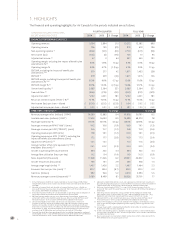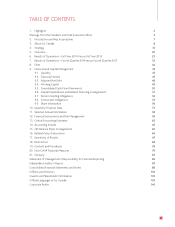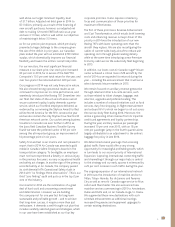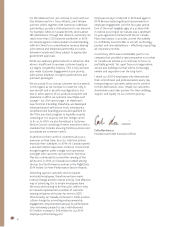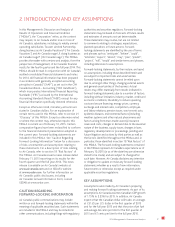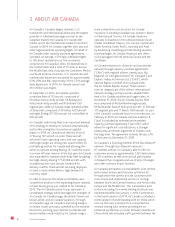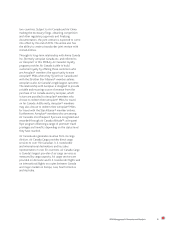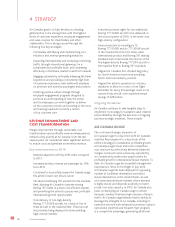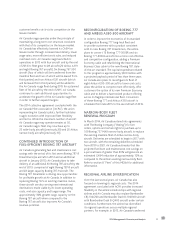Air Canada 2014 Annual Report Download - page 12
Download and view the complete annual report
Please find page 12 of the 2014 Air Canada annual report below. You can navigate through the pages in the report by either clicking on the pages listed below, or by using the keyword search tool below to find specific information within the annual report.
12 2014 Annual Report
all of its 15 Embraer 175 aircraft from the mainline
fleet to Sky Regional which operates these aircraft
on behalf of Air Canada at a much lower-cost. In
addition, since 2014, Air Georgian, also a lower-cost
regional provider, operates a number of regional
routes on Air Canada’s behalf using Bombardier
CRJ-100 and Beechcraft 1900. In 2015, Air Canada
plans to continue to seek opportunities to further
reduce regional costs and optimize its regional fleet
deployment.
On February 2, 2015, Air Canada announced that it
had concluded an amended and extended capacity
purchase agreement with Jazz, a wholly owned
subsidiary of Chorus Aviation Inc. The agreement
provides both parties with greater stability and
significant cost reductions through a better alignment
of their interests. The agreement also provides
for long-term stability by eliminating the risks,
uncertainties and set-up costs of a potential transition
to alternative regional providers in 2021. Post-2020,
Air Canada expects Jazz will provide competitive costs
and continued high service levels.
The highlights of the new capacity purchase
agreement include:
• Extension of the term by five years to
December 31, 2025
• Establishment of a pilot mobility agreement that
provides Jazz pilots with access to pilot vacancies
at Air Canada, thus allowing a significant reduction
in Jazz operating costs
• Simplification and modernization of the Jazz fleet
which will provide improved service and greater
efficiency through the addition of 23 Bombardier
Dash 8-Q400 aircraft
• Reduction in Air Canada and Jazz costs derived
from a combination of improved fleet economics,
greater network flexibility and reduced operating
and labour costs. This supports Air Canada’s cost
reduction initiatives
• Modification of Jazz’s CPA fee structure, moving
from a “cost plus” mark-up to a more industry
standard fixed fee compensation structure. This
provides a more competitive structure and better
aligns the cost reduction goals of both Air Canada
and Jazz. This change also eliminates non-value
added costs and the necessity of the 2015
benchmarking exercise
OTHER REVENUE OPTIMIZATION AND
COST REDUCTION INITIATIVES
Air Canada continues to foster a culture of continuous
cost transformation and revenue improvement across
the organization. To this end, Air Canada’s Business
Transformation team actively pursues its mission
to identify and help implement initiatives through
productivity enhancements, process reforms and
other measures. Initiatives may include revising
business and operational processes, including supply
chain and maintenance operations, improving
employee productivity and asset utilization,
consolidating call centres and promoting workplace
policies to drive revenue and reduce costs. The airline
is also implementing a continuous improvement
program at airports which will also optimize supplier
arrangements and reduce aircraft turnaround times.
Lowering distribution costs, including through the
renegotiation of global distribution system (“GDS”)
and other agreements, is another key initiative aimed
at increasing margins.
In the area of yield management, Air Canada is
implementing a new passenger revenue management
system to optimize its revenue performance on the
basis of a passenger’s full trip itinerary rather than on
individual flight legs. Given the number of connecting
passengers Air Canada serves, this new system will
allow the airline to better optimize passenger flows
across the network. Air Canada estimates that this
initiative, which will be implemented in the second
quarter of 2015, will drive incremental annual revenues
in excess of $100 million.
Air Canada is also increasing its ancillary revenues
through onboard retail and other à la carte services,
such as those related to ticket changes, baggage,
seat selection, upgrades, preferred seating, as well as
onboard offerings, including food, duty free shopping,
in-flight entertainment and onboard Wi-Fi.
The airline is also generating revenues from its
tripartite credit card agreements and loyalty
partnerships. New and renewed financial card
partnerships in conjunction with Aeroplan help bolster
overall ancillary revenues and enhance cardholders’
travel experience by providing complimentary travel
benefits, such as first checked baggage, priority check-
in and certain access to Maple Leaf Lounges. These
Aeroplan co-brand financial card partner agreements
included the introduction of TD co-branded cards as
well as the renewal of the American Express and CIBC
card partnerships.
To better monetize its ancillary offerings and
increase related revenues, in August 2014, Air Canada
introduced a new merchandising tool to help
customize, differentiate and combine its offerings. This
new tool also provides the airline with the ability to
more quickly introduce new products.
In 2014, Air Canada’s ancillary revenue per passenger
increased 10% when compared to 2013.


